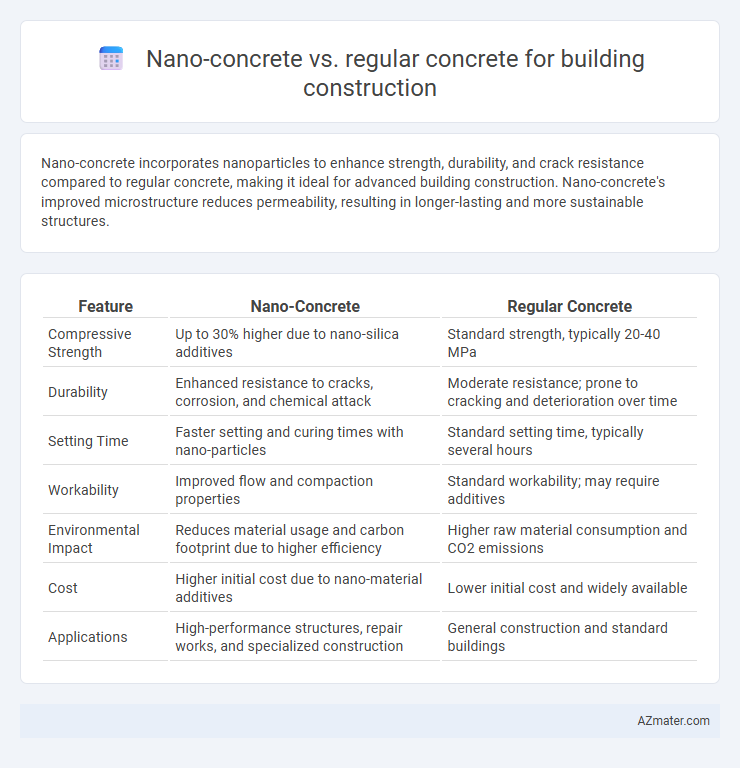Nano-concrete incorporates nanoparticles to enhance strength, durability, and crack resistance compared to regular concrete, making it ideal for advanced building construction. Nano-concrete's improved microstructure reduces permeability, resulting in longer-lasting and more sustainable structures.
Table of Comparison
| Feature | Nano-Concrete | Regular Concrete |
|---|---|---|
| Compressive Strength | Up to 30% higher due to nano-silica additives | Standard strength, typically 20-40 MPa |
| Durability | Enhanced resistance to cracks, corrosion, and chemical attack | Moderate resistance; prone to cracking and deterioration over time |
| Setting Time | Faster setting and curing times with nano-particles | Standard setting time, typically several hours |
| Workability | Improved flow and compaction properties | Standard workability; may require additives |
| Environmental Impact | Reduces material usage and carbon footprint due to higher efficiency | Higher raw material consumption and CO2 emissions |
| Cost | Higher initial cost due to nano-material additives | Lower initial cost and widely available |
| Applications | High-performance structures, repair works, and specialized construction | General construction and standard buildings |
Introduction to Nano-Concrete and Regular Concrete
Nano-concrete incorporates nanoparticles such as nano-silica to enhance the microstructure, resulting in improved mechanical strength, durability, and reduced permeability compared to regular concrete. Regular concrete, composed of cement, water, aggregates, and sometimes additives, serves as the conventional building material relied upon for its compressive strength and versatility in construction. The integration of nanotechnology in nano-concrete optimizes hydration and fills micro-pores, leading to superior performance in load-bearing and environmental resistance applications.
Composition and Material Differences
Nano-concrete incorporates nanoparticles such as nano-silica and carbon nanotubes that enhance the microstructure, improving strength and durability compared to regular concrete, which relies primarily on cement, aggregates, and water. The nanoscale additives in nano-concrete promote better hydration and reduce porosity, resulting in increased compressive strength and resistance to cracking. Regular concrete lacks these nano-sized reinforcements, making it more prone to micro-cracks and lower overall performance under stress.
Mechanical Strength Comparison
Nano-concrete exhibits significantly higher mechanical strength compared to regular concrete due to the incorporation of nanoparticles like nano-silica, which enhance particle packing density and reduce microcracks. Studies reveal that nano-concrete can achieve compressive strength improvements of up to 30-50%, attributed to its refined microstructure and increased hydration efficiency. This superior mechanical performance makes nano-concrete particularly advantageous for high-load structural applications in building construction.
Durability and Longevity
Nano-concrete incorporates nanoparticles that enhance the microstructure, significantly improving its durability and resistance to cracking compared to regular concrete. Studies show nano-concrete exhibits superior compressive strength and reduced permeability, leading to enhanced protection against environmental degradation and chemical attacks. These properties result in extended longevity for structures using nano-concrete, making it a more durable choice for building construction.
Setting Time and Workability
Nano-concrete exhibits significantly faster setting times compared to regular concrete due to the enhanced hydration kinetics driven by nanoparticles such as nano-silica. The incorporation of nanoparticles also improves workability by reducing water demand and refining the microstructure, resulting in a smoother and more cohesive mix. These advantages make nano-concrete a superior choice for construction projects requiring rapid setting and ease of application.
Cost Analysis and Economic Impact
Nano-concrete, enhanced with nanoparticles such as silica, offers superior strength and durability compared to regular concrete, leading to lower maintenance and longer service life, which can offset its higher initial material costs. The incorporation of nano-additives improves concrete performance, reducing the quantity required and enabling faster construction timelines, translating into significant labor and operational cost savings. Economic analyses reveal that although nano-concrete has a higher upfront cost--typically 15-30% more--the long-term benefits through enhanced lifespan, reduced repairs, and energy efficiency deliver a compelling return on investment in building construction projects.
Environmental Considerations
Nano-concrete incorporates nanoparticles like nano-silica to enhance strength and durability, leading to longer-lasting structures and reduced material use compared to regular concrete. The improved performance of nano-concrete lowers the frequency of repairs and replacements, decreasing overall carbon emissions and resource consumption in building construction. Moreover, nano-concrete can reduce the cement content needed, which directly contributes to a smaller carbon footprint due to cement production's significant environmental impact.
Applications in Modern Building Construction
Nano-concrete enhances structural strength, durability, and resistance to environmental factors compared to regular concrete, making it ideal for high-rise buildings and infrastructure exposed to harsh conditions. Its improved microstructure reduces permeability, extending the lifespan of bridges, tunnels, and marine structures where durability is critical. Modern building construction leverages nano-concrete for lightweight, high-performance components that support sustainable design and energy efficiency.
Challenges and Limitations
Nano-concrete offers enhanced strength and durability compared to regular concrete but faces challenges such as higher production costs and the need for advanced manufacturing technologies. The integration of nanoparticles can lead to issues with uniform dispersion and potential health risks during handling. Regular concrete, while more economical and widely available, often suffers from lower tensile strength and durability, limiting its long-term performance in certain structural applications.
Future Trends and Innovations in Concrete Technology
Nano-concrete incorporates nanomaterials like carbon nanotubes and nanosilica to enhance strength, durability, and self-healing properties compared to regular concrete, paving the way for more sustainable and resilient infrastructure. Future trends in concrete technology emphasize smart materials with embedded sensors for real-time structural health monitoring and the integration of eco-friendly nanomaterials to reduce carbon footprint and improve performance. Innovations such as 3D printing using nano-reinforced concrete and advanced nano-engineering techniques are expected to revolutionize construction by enabling faster build times, enhanced material efficiency, and greater design flexibility.

Infographic: Nano-concrete vs Regular concrete for Building construction
 azmater.com
azmater.com